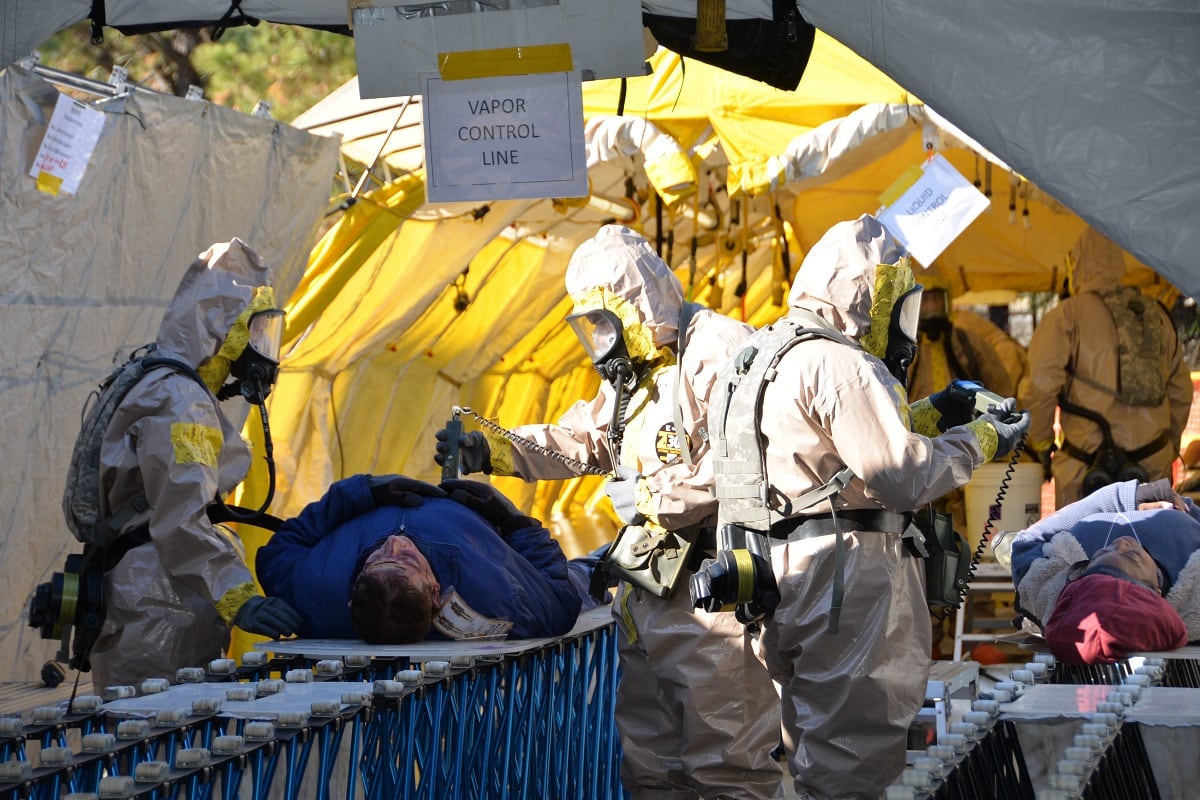While the Army last week announced that it would not be sending troops back stateside for permanent change-of-station moves from South Korea or Italy until further notice, senior Pentagon officials confirmed Tuesday that the Defense Department is working on a policy for the entire military in the face of the spreading coronavirus.
That includes both PCS moves out of COVID-19 hotspots, as well as into them, and potentially policies restricting deployments into other parts of the world.
“We’re coming to an agreement across the department as far as personnel movements,” Adm. Bill Byrne, the Joint Staff vice director, told reporters. “Especially because the summer move period is coming up soon. So we haven’t decided on the department-wide policy yet.”
Separately, Navy, Marine Corps and Air Force commanders are considering specific policies for South Korea and Italy, Pentagon spokesman Jonathan Hoffman confirmed.
Spring and summer are also a big time for international military exercises. Some based in South Korea have been canceled, while Defender Europe 2020 is still on. Operation African Lion has been limited, Hoffman said, in Morocco and Tunisia.
Shorter exercises have been first on the chopping block, he said, because participation would tack on a post-exercise 14-day isolation period, which would be longer than the exercises themselves.
Though the Defense Department is aware of less than a dozen of its personnel and dependents who have been diagnosed with or are presumed to have COVID-19, the disease caused by the newest coronavirus strain, the Pentagon’s top doctor is confident that not only will the virus continue to spread, service members without symptoms are likely carrying the virus around right now.
“I think that it is likely given what we’re seeing around the world, and the fact that we have people all over the world, that there are more than eight people carrying the coronavirus," Brig. Gen. Paul Friedrichs told reporters, referring to the number of known DoD cases.
That opinion is similar to recently released CDC guidance, stressing that the elderly and immunocompromised are most at risk, but that asymptomatic carriers are still contagious.
Officials have also reiterated that currently, COVID-19′s mortality rate is dwarfed by the seasonal flu. The flu, however, has a readily available vaccine, and health care providers highly recommend that children, the elderly, health care workers, educators and other high-risk populations get it every year.
'The reason that we’re taking the precautions that you’re seeing is this is a new virus," Friedrichs said.
RELATED

As the weeks go on, he said, officials will learn more about how the virus spreads, whether it turns out to be seasonal and how best to contain it.
While healthy young people, like most of the military, are at a low risk, there is still a possibility that asymptomatic service members could spread the virus to their families and community members, putting those with decreased immunity at imminent risk.
“I don’t anticipate right now that we would test the whole force, if you will,” a senior defense official, speaking on background, told reporters March 10.
One containment option is the Navy’s current procedure for sailors on deployment, putting 14 days in between port calls and restricting underways to at least 14 days, so that any symptoms will pop up before a ship returns home again.
Since coronavirus began spreading late last year, three service members, four military dependents, one DoD civilian and one DoD contractor have been diagnosed as of March 10, out of more than 80,000 cases worldwide.
Five of those cases were based in Daegu, South Korea, while there are two confirmed ― one Fort Belvoir, Virginia-based Marine, one Italy-based sailor. There are six more DoD-affiliated personnel who have at least had a first test, Friedrichs said, but will need two positives for an official diagnosis, including a service member at Joint Base Lewis McChord, whose spouse has been confirmed positive.
As of March 10, Friedrichs told reporters, 13 military labs had received coronavirus test kits, which are able to perform about 400 tests each. Per his latest briefing, he said, military providers had performed about two dozen tests, most of which had come back negative.
The military’s policy has been to do a local test, and if positive, send a second sample to the CDC in Atlanta.
Throughout the uniformed and civilian force, the DoD has authorized department heads and installation commanders to allow working from home, canceling large events and limiting base access, among other measures.
“The goal is to do what is is prudent up front in an effort to prevent the potential spread of coronavirus,” Pentagon spokesman Jonathan Hoffman told reporters.
At the Pentagon, senior leadership began “social distancing” on March 9, taking care to give attendees of meetings and briefings at least three feet of personnel space, per the CDC’s recommendations for reducing airborne transmission of the virus.
“This morning we had a meeting at the senior level that is normally as many people as you can cram into a room for a meeting, and we actually broke that out into a number of rooms,” Hoffman said, dropping from what would has been 50 people in one conference room to 20 or 25, then linking other rooms by teleconference.
The Pentagon also announced Tuesday that Defense Secretary Mark Esper would be canceling a mid-March trip to India, Uzbekistan and Pakistan. There were concerns that those traveling with the secretary, including press, could be forced into quarantines in those countries if they exhibited any symptoms while arriving or departing during each legs of the trip, officials said.
Meghann Myers is the Pentagon bureau chief at Military Times. She covers operations, policy, personnel, leadership and other issues affecting service members.





